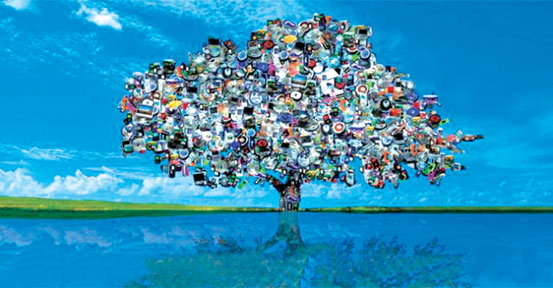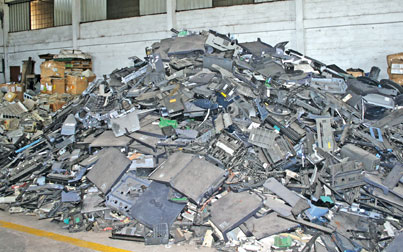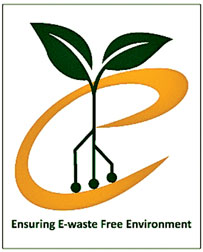|
E-waste:
Deadly disaster in the making
By Shanika SRIYANANDA
Among his toys, the old mobile phone is Arun's favourite. He does not
much like the other fancy mobile phone added to his heap of toys
recently. Both these phones, used by his mum and dad, have no life now
and were given to Arun to play. The little boy of four years used them
as walkie-talkies when he played hide-and-seek with his friend Ranul.
 Inquisitive about the parts which formed the phone, Arun started
dismantling the two phones one day. First he threw out the batteries to
the garden as they were not so attractive. Then he was able to get the
circuit of a phone out by hammering on it with his toy mammoty. As the
phone was in pieces, the maid who looks after Arun had to throw them
away to avoid being blamed for her 'negligence'. She threw away the
pieces to the adjoining barren land, where the neighbour was planning to
build a house soon. Inquisitive about the parts which formed the phone, Arun started
dismantling the two phones one day. First he threw out the batteries to
the garden as they were not so attractive. Then he was able to get the
circuit of a phone out by hammering on it with his toy mammoty. As the
phone was in pieces, the maid who looks after Arun had to throw them
away to avoid being blamed for her 'negligence'. She threw away the
pieces to the adjoining barren land, where the neighbour was planning to
build a house soon.
Not much aware or concerned about the 'danger' which they may have
faced due to dismantling the phone and throwing away the dead battery,
the duo was more upset and worried about losing the two phones, which
held sentimental value, as one was the first ever phone of Arun's father
and the second a gift from him to his wife on their first wedding
anniversary.
Arun's house also stored other 'ancient' and broken electronic
devices such as their first washing-machine, refrigerator and rice
cooker in their congested garage.
Strictly warned by the parents not to destroy their 'e-waste with
sentimental value', the little boy still plays with one of the broken
mobile phones, while the 'remnants' including the two 'lifeless'
batteries and circuits are adding deadly chemicals - lead, mercury,
nickel, cadmium, lithium and electrolytes - to the soil.
"Parents should not allow children to play with 'end of life'
electronic devices as there are chances for them to get exposed to the
dangerous chemicals in them. When people are exposed to chemicals from
e-waste it could damage the brain and nervous system, affect the kidneys
and liver, and cause birth defects in children to be born", Director,
Environmental Health and Occupational Health of the Ministry of Health
Dr. Ananda Jayalal said.
 |
 |
| Charitha Herath |
Nalin Sirilal
Gunaratne |
He said the batteries of old mobile phones pose a great threat to Sri
Lanka as nearly 10 million people use mobile phones now. "What will
happen to these batteries, which have a lifespan of only five years?
They need to be discarded in an eco-friendly manner to save human lives
as well as the environment", he said.
Dr. Jayalal said there are people who collect end of life electronic
items such as computers, rice cookers, batteries and DVD and CD players
to collect parts to be sold, but the remaining parts are destroyed in
open areas or thrown into waterways.
"When burnt, heavy metals such as lead, cadmium and mercury in the
e-waste are released into the air and deposited as ashes. Mercury
released into the atmosphere can bio-accumulate in the food chain,
particularly in fish - the major route of exposure for the public. If
the products contain PVC, highly toxic dioxins and furans are also
released. Brominates and flame retardants generate brominate dioxins and
furans when e-waste is burned", he said.
The number of discarded, obsolete or broken electrical or electronic
devices, which are fondly called 'e-waste', is a deadly disaster in the
making with a growing number of electronic devices designed to make
human lives easier, entering the market on a daily basis.
According to current estimates, e-waste is growing at almost three
times the rate of municipal waste globally and the present e-waste
market was forecast to reach 53 million tonnes by 2010 from 42 million
tonnes in 2008 as the electronics and information technology industry
became the world's largest and fastest growing manufacturing industry.
 |
|
Piles of e-waste
collected |
At the sixth meeting of the Conference to the Parties to the Basel
Convention on the Control of Transboundary Movement of Hazardous Waste
and Their Disposal, e-waste was considered one of the main streams of
waste to be managed properly to prevent damage to human lives and the
environment.
E-waste, which contains over 38 chemicals which are harmful to human
health, is of concern largely due to the toxicity and carcinogenicity of
some of the substances if processed improperly.
Chairman, Central Environmental Authority (CEA), Charitha Herath said
e-waste management, which was not given much consideration for some
years, was now given prime attention on the CEA's waste management
policy as it would cause much damage to the country in future, if left
un-noticed.
Appeal to donors
CEA has launched the e-waste management project with the assistance
of 14 private sector partner organisations - including Sri Lanka
Telecom, Mobitel, Dialog, Etisalat, Hutch and Lanka Bell from the
telecommunications industry, Singer and Abans from the home appliances
industry, Metropolitan, E-Wis, Virtusa and ABC Trade and Investments
from the office appliances industry together with service providers Geo
Cycle and Green Link to collect e-waste in the country.
"The first ever e-waste day to collect electronic items with end of
life will be held on April 7. We invite those who want to dump their
unwanted electronic items to hand them over to these companies", he
said.
Herath said there was no target for the day's program, but they aim
at collecting as much e-waste as possible. "Sri Lankans have a habit of
preserving all their used electronics and don't want to give them away
for nothing. But e-waste has no price, and only cause harm if they are
stored or thrown into open garbage dumps. We think we can collect nearly
50 percent of old electronics from houses, offices and other
institutions", he said.
Meanwhile, the CEA Chairman also appealed to international donors not
to donate electronic items such as computers, laptops and printers,
which are nearing the end of their life. "Some agencies have donated
computers, printers, CD players and projectors which have only a few
years of life left. Sri Lanka is not a dumping ground for e-waste any
more and we call upon the donors to make the donation more meaningful by
donating useful electronic items", Herath said.
People who want to get rid of old electronic items can dial 1919, the
Government Information Centre, to get the contact number of the nearest
outlet of the e-waste project partners to hand over their items.
 "The collected e-waste will finally be handed over to the company at
Wattala, where they are dismantled following international safety
guidelines", he said. "The collected e-waste will finally be handed over to the company at
Wattala, where they are dismantled following international safety
guidelines", he said.
Green Link, the e-waste subsidiary of N.S. Gunaratne and Co., which
has the local and international licences from the Basel Convention and
the CEA, is the only company which exports e-waste from Sri Lanka.
Managing Director of Green Link, Nalin Sirilal Gunaratne said e-waste
was still a hidden danger waiting to strike the country as many
electronic items still remain 'hidden treasures'.
There is no proper count on the country's e-waste stocks, but Green
Link has shipped over 2,000 tonnes of electronic waste during the past
two to three years.
Private sector
Gunaratne seeks more assistance from the 14 private sector partners
in the e-waste project to get the e-waste out into the open. "Now there
is greater awareness among the people compared to earlier, but it is not
enough to bring the remaining e-waste stocks out. I have only got 20
tonnes of e-waste through those private partners over the last four
months, since we launched the project. According to rough estimates,
there could be thousands of tonnes of e-waste still untouched", he said.
Gunaratne said though he doesn't pay the e-waste owners for the items
they hand over, the company has to spend a huge amount of money on them
as they had to follow tough safety rules in dismantling them under the
Basel Convention. "I have to look after my workers and it's a costly
process. I think assisting the management of e-waste is a social
responsibility", Gunaratne said describing the process of safe
transportation, storing, segregating and exporting e-waste.
He said thanks to the CEA, people were more aware of the danger of
e-waste and that 'preserving' old electronics would bring nothing but
serious harm to their health and also to the environment.
Green Link targets collecting over 1,000 tonnes of e-waste per year
with increased awareness among the public and according to Gunaratne the
e-waste camp would be a significant step towards managing e-waste
properly.
Believe it or not! Over seven million CDs are imported to Sri Lanka
which has over 15 million mobile phone users. It's still unknown how
they destroy the CDs which contain deadly mercury and other chemical
coatings. They end up mostly in open garbage dumps with no one noticing
the damage caused to waterways and the atmosphere.
Out of the thousands of mobile phones nearing the end of their life,
Green link has exported only 20,000 tonnes of mobile phones so far. The
rest remain as toys or gather dust somewhere in the country.
The time has come to hunt out your 'electronic treasures' - aged
computers, blenders and all other electronic devices - whether they are
at your home or workplace and hand them over to the e-waste collectors,
to make your contribution towards a better place for future generations
to live.
|

